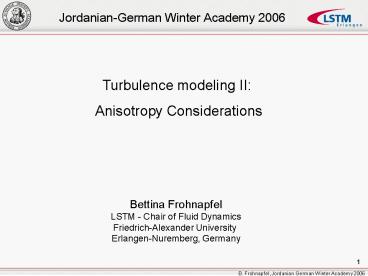Turbulence modeling II: - PowerPoint PPT Presentation
1 / 27
Title:
Turbulence modeling II:
Description:
Jordanian-German Winter Academy 2006 Turbulence modeling II: Anisotropy Considerations Bettina Frohnapfel LSTM - Chair of Fluid Dynamics Friedrich-Alexander University – PowerPoint PPT presentation
Number of Views:312
Avg rating:3.0/5.0
Title: Turbulence modeling II:
1
Jordanian-German Winter Academy 2006
Turbulence modeling II Anisotropy
Considerations
Bettina Frohnapfel LSTM - Chair of Fluid
Dynamics Friedrich-Alexander University
Erlangen-Nuremberg, Germany
2
OVERVIEW
- How to solve turbulent flow problems?
- Review of Reynolds averaging and the need for
turbulence models - Transport equations of the Reynolds stresses
- Is turbulence isotropic?
- Introduction of the anisotropy invariant map
- Introduction of two-point correlation technique
- Model formulation of anisotropy invariant
turbulence model
3
HOW TO SOLVE THE BASIC EQUATIONS IN TURBULENT
FLOWS
- DNS Direct Numerical Simulation
- Solves the unsteady Navier-Stokes equations
directly. - RANS Model (Reynolds Averaged Navier-Stokes
Model) - Motivation Engineers are normally interested in
knowing just a few quantitative properties of a
turbulent flow. - Method Using Reynolds-Averaged form of the
Navier-Stokes equations with appropriate
turbulence models. - LES Large Eddy Simulation
- MotivationThe large scale motions are generally
much more energetic than the small scales, and
they are the most effective transporters of the
conserved properties. - Method Large Scales -gt Solve, Small Scales
-gtModel
4
REYNOLDS AVERAGING AND THE CLOSURE PROBLEM
continuity equation
RANS
5
TURBULENCE MODELLING
Eddy Viscosity Model Reynolds Stress Model PDF
Model (probability density function)
accuracy
complexity
6
EDDY VISCOSITY VS. REYNOLDS STRESS MODELS
Eddy viscosity models
k-e model
solve transport equations for k and e
Reynolds stress models
solve transport equation for Reynolds stresses
7
REYNOLDS STRESS MODEL
Transport equation for Reynolds stresses
Pij
Tij
eij
Pij
Dij
transport equation contains three unknown
correlations that need to be modeled !
8
IS TURBULENCE ISOTROPIC?
Flow structure in the wake behind a bullet
Artificially produced patterns
Flows visualisation of small-scale structure of
turbulence at large Re
(a) isotropic pattern, (b) and (c) are
anisotropic patterns
9
ANISOTROPY INVARIANT MAP
IIa aijaji
IIa
two component turbulence
IIIa ajkakjaij
axisymmetric turbulence
k- e Model
IIIa
Lumley and Newman 1977 Lumley 1978
isotropic turbulence
10
TURBULENT CHANNEL FLOW IN AI MAP
wall y0
channel centerline yd
y0
y0
y0
yd
yd
yd
Decaying Reynolds number
11
TURBULENT PIPE FLOW IN AI MAP
y0
yd
IIa
IIa
y0
yd
IIIa
IIIa
12
TRAJECTORIES THROUGH AI MAP
flow through sudden expansion
turbulent scalar transport with mixing
x
H
13
TWO POINT CORRELATION TECHNIQUE
Chou (1945), Kolovandin and Vatutin (1969-1972)
separate effects of local character from large
scale fluid motions
B
A
14
REYNOLDS STRESS MODEL
transport equation for the Reynolds stresses
where
transport equation for the homogeneous part of
the dissipation
15
MODELLING OF DISSIPATION EQUATION
interpolation functions
16
MODELLING OF TRANSPORT EQUATION FOR REYNOLDS
STRESSES
17
DYNAMIC EQUATIONS FOR INHOMOGENEOUS ANISOTROPIC
TURBULENCE
18
TEST CASES FOR HOMOGENEOUS FLOWS
as given by Stanford conference (1980), compiled
by Ferzinger
19
TEST CASES FOR HOMOGENEOUS FLOWS
axisymmetric strain
plain strain
20
TEST CASES FOR HOMOGENEOUS FLOWS
imposed rotation
simple shear
accuracy of predictions for homogeneous flows
5 in kinetic energy and 10 in Reynolds stresses
21
INHOMOGENEOUS FLOWS
Flow Over a Backward-Facing Step
reattachment length - experimentally 6.1H
Velocity profiles at stations x/H 4,
6.5, 8, 14, 32.
From left to right n 0,1,2,3,4 and 5
22
INHOMOGENEOUS FLOWS
Flow Over a Backward-Facing Step Reynolds
stress components
23
INHOMOGENEOUS FLOWS
Flow over a periodic arrangement of hills
The mesh of hill flow test case.
24
SWIRL FLOW - EXPERIMENTAL DATA
25
SWIRL FLOW - SIMULATION DATA
k-e - Model
AIRSM - Model
mean velocity profiles at x/D 3, 10, 17.3,
37.3, 44.8, 52.3, 81.7, 98.4
26
INDUSTRIAL COMPUTATIONS
Illustration of an exemplary geometry used for
the stationary blow experiment
Cross section of the velocity distribution in the
tumble channel (AI-computations)
27
CONCLUSIONS AND OUTLOOK
- Reynolds stress models provide more accurate
predictions than eddy viscosity models but need
more computational time - In Reynolds stress models anisotropy
considerations can be taken into account - AIRSM - Anisotropy Invariant Reynolds Stress
Model is based on nearly no empirical input - AIRSM shows good prediction quality and can be
improved systematically - Computer power is constantly increasing so that
direct numerical simulations (DNS) can be
increasingly used for engineering predictions

